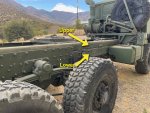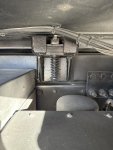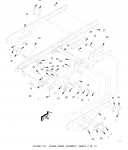Kevin Means
New member
- 1
- 0
- 1
- Location
- Hereford, Arizona
Hi. Kevin here and this is my first post. I've been reading LOTS of posts over the last few months and found them to be very helpful, but now it's time to start asking questions. We purchased a 1998 Stewart & Stevenson M1083 a few months ago for the purpose of turning it into an off-road RV. We've been RVers for decades, but we'd really like to go places that stock RVs can't go.
I understand that we'll have to build a subframe to avoid breaking the habitat, because we're planning to build a habitat with "foam" core walls. (We haven't decided exactly which type yet) The M1083 has upper and lower frame rails that are bolted together with bolts and Huck bolts. I removed the 20 Huck bolts in the upper rails that attached the factory bed to those rails (boy, that was fun.) I was initially planning to put the subframe on top of the upper rails, but as I looked at it, I started wondering if I could just use the upper set of frame rails as the subframe. That would help keep the overall height down, which is something I'm concerned about.
We're planning on installing a pass-through, so all of the spare tire equipment and air intake stuff will be relocated. While studying subframe designs, I've found that the majority of builders rigidly attach the rear of the subframe to the rear of the chassis' frame rails, and then they use springs to allow the forward part of the subframe to move independently of the frame rails. It seems to me that that could cause the pass-through boot to move around a lot. Is there a reason that we couldn't reverse the mounts? That is - rigidly attach the forward part of the subframe to the frame rails and spring-mount the rails toward the rear?
Kev
I understand that we'll have to build a subframe to avoid breaking the habitat, because we're planning to build a habitat with "foam" core walls. (We haven't decided exactly which type yet) The M1083 has upper and lower frame rails that are bolted together with bolts and Huck bolts. I removed the 20 Huck bolts in the upper rails that attached the factory bed to those rails (boy, that was fun.) I was initially planning to put the subframe on top of the upper rails, but as I looked at it, I started wondering if I could just use the upper set of frame rails as the subframe. That would help keep the overall height down, which is something I'm concerned about.
We're planning on installing a pass-through, so all of the spare tire equipment and air intake stuff will be relocated. While studying subframe designs, I've found that the majority of builders rigidly attach the rear of the subframe to the rear of the chassis' frame rails, and then they use springs to allow the forward part of the subframe to move independently of the frame rails. It seems to me that that could cause the pass-through boot to move around a lot. Is there a reason that we couldn't reverse the mounts? That is - rigidly attach the forward part of the subframe to the frame rails and spring-mount the rails toward the rear?
Kev
Attachments
-
341.6 KB Views: 13





